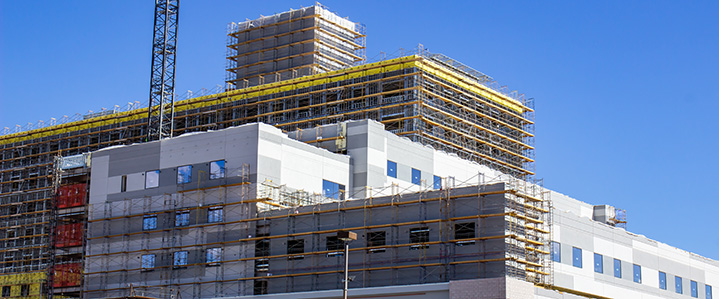Solving the Unexpected Problem of the New USP 797 Sporicidal Disinfectant Requirement

After many delays, the revised USP General Chapter 797 providing guidance on sterile compounding will go into effect on November 1, 2023. While pharmacies have been aware of the update and preparing to meet it for some time now, one change is proving to have unexpectedly significant complications that must be addressed by cross-hospital teams.
The revised chapter sets a requirement for monthly disinfecting with a sporicidal disinfectant on all surfaces. It’s a change that was already included in USP 800. Many facilities have already begun using products comprising peracetic acid, acetic acid, and hydrogen peroxide to clean their primary engineering controls. The key difference is that, in most instances, if sporicides are currently being used it is to disinfect in negatively pressurized rooms. Once these chemicals are applied across positively pressurized rooms in compliance with USP 797, the sporicide’s strong, offensive odor will be pushed out into adjacent corridors and departments.
The strong smell – and the respiratory irritation it elicits – will likely require anyone cleaning these spaces to adopt new personal protective equipment (PPE). It will likely lengthen the amount of time before pharmacists can return to compounding following disinfecting. Moreover, certain pharmacy locations will need to consider how the smell may be perceived by other staff, as well as patient populations.
The use of sporicides in sterile compounding spaces is not just a pharmacy issue. It’s a problem that will need to be addressed by teams including pharmacy, environmental services, occupational health and safety (OHS), the facilities department, and infection prevention.
The impact of the sporicide problem
This isn’t the first time that hospitals have faced this type of issue. Nearly a decade ago, many central processing departments transitioned to the use of products containing peracetic acid to serve as a high-level disinfectant. Even at a low volume within the closed system of reprocessors, the pungent smell led to numerous complaints. Now, the same substance will be used on virtually every surface of positive pressure cleanrooms.
In hospitals where EH&E has begun qualitative assessments, the impact of the disinfectant in adjacent spaces was almost immediate. In one pharmacy, applying the disinfectant between 6 to 8 p.m. in a pharmacy – a positively pressurized space connected to a small anteroom, a work room, and then a corridor within the ICU – led to staff complaints in both the pharmacy and ICU at 7 a.m. the following morning.
The good news is that with advanced awareness of this issue there are steps facilities can take today to prepare. In order to develop a plan, teams will need to consider three key factors:
1. The impact to employees performing the disinfection.
As dictated by OSHA, a quantitative assessment that measures the presence of peracetic acid, acetic acid, and hydrogen peroxide within compounding rooms during disinfection to compare concentrations with occupational exposure limits. The results will dictate whether individuals cleaning the equipment and rooms will need to wear a respirator.
If that is confirmed to be the case, cleaning professionals must then be medically cleared for respirator use, a respirator must be selected, and the individual may need to be fit-tested for an appropriate solution. Staff will have to be entered into the respiratory protection program, and OHS staff may have to adjust their written respiratory protection document.
2. How long staff must wait before reentering the space without respiratory protection.
Once the space is disinfected, facilities will need to determine the window of time required before people can reenter the space. The most offensive of these chemicals, the peracetic and acetic acids, have low short-term exposure limits. Because the specific window will vary based on a range of factors, it will be necessary to perform quantitative area measurements of peracetic acid, acetic acid, and hydrogen peroxide within the compounding rooms at specific intervals following disinfection.
While the odor may linger beyond the time deemed safe for pharmaceutical staff to reenter the room, an assessment will provide the clear data staff needs to trust that they are safe.
3. Spaces adjacent to where the disinfection is performed.
Pharmacies located adjacent to occupied areas face the potential for complaints about offensive odors from staff and patients during the window after these products are used. Have a pharmacy located near your ICU? In the middle of the emergency department? Near your operating rooms or in the center of your oncology space? These sensitive spaces should provide a starting point from which to plan your response.
Quantitative area measurements in these areas adjacent to compounding can assess concentrations of sporicides and qualitative assessments of odors can help facilities determine whether temporary controls should be implemented.
A range of variables demands a cross-department response
These assessments are essential due to the range of variables that will dictate the chemical’s staying power and impact on surrounding populations. Variables include the size of the space, air exchange rates, whether a space is conditioned by exhaust or return air systems, and the arrangement of rooms. For instance, a cleanroom suite in which a negative pressure room is connected to two positive pressure rooms may see concentrations decrease more rapidly than a suite made up of all positively pressurized rooms.
These assessments can provide insight into next steps, but it will be essential to have multiple teams involved to take those steps. In additional to impacted cleaning vendors or environmental services staff, discussions should include:
- Occupational health and safety team: This team is an essential partner in ensuring respirator use is safe and fully in line with OSHA requirements. Many OHS departments will already have familiarity with the issues around these products and can provide response guidance. However, they may not yet be aware of sporicide’s required use in the pharmacy environment.
- Facilities department: Engineering controls can help mitigate irritation and offensive odors and may be particularly important in sensitive population areas. Although it is common to negatively pressurize a unit to address odor concerns, this can’t be done during cleaning in this instance. Building engineers will need to identify where controls are needed and develop an effective strategy.
- Infection prevention: As building engineers propose new solutions for mitigating odors associated with these chemicals, infection prevention teams must be present to ensure solutions don’t create new problems that could compromise patient health.
- Pharmacy staff: This department is hard at work preparing for the vast range of changes that will be required come November 1. A change in cleaning solution may seem minor in comparison to the other issues with which they are dealing. However, it’s essential that pharmacy staff be made aware of this problem so that they are not blindsided by odors or changes to cleaning procedures.
In addition, organizations may need to bring in an industrial hygienist to perform the assessments and provide data to guide new policies and procedures.
Build the right team to guide your response
There is no compliance requirement to implement procedures to mitigate the risk of odor due to sporicides. However, based on insight from facilities that have already taken this step, it’s evident these chemicals pose a significant organizational problem.
By pulling in all of the appropriate partners, hospitals can easily mitigate this risk and move forward in full compliance with USP 797. To learn how EH&E is partnering with hospitals to provide assessments, reporting, building controls, and insight, contact us today.
Subscribe
to our blog
"*" indicates required fields




